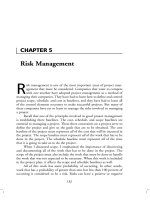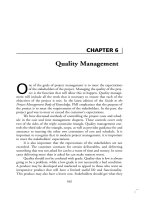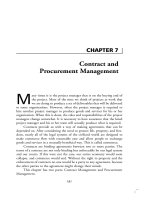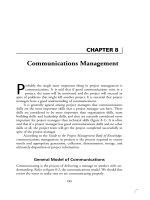Tài liệu Project Management Professional-Chapter 8 ppt
Bạn đang xem bản rút gọn của tài liệu. Xem và tải ngay bản đầy đủ của tài liệu tại đây (153.8 KB, 16 trang )
CHAPTER 8
Communications Management
P
robably the single most important thing in project management is
communications. It is said that if good communications exist in a
project, the team will be motivated and the project will succeed in
spite of problems that might kill another project. It is essential that project
managers have a good understanding of communications.
It is generally agreed among project managers that communications
skills are the most important skills that a project manager can have. These
skills are considered to be more important than organization skills, team
building skills, and leadership skills, and they are certainly considered more
important for project managers than technical skills (figure 8-1). It is often
said that if a project manager has good communications skills and no other
skills at all, the project team will get the project completed successfully in
spite of the project manager.
According to the Guide to the Project Management Body of Knowledge,
communications management in projects is the process required to ensure
timely and appropriate generation, collection, dissemination, storage, and
ultimately disposition of project information.
General Model of Communications
Communicating is the process of delivering a message to another with un-
derstanding. Refer to figure 8-2, the communications model. We should first
review the terms to make sure we are communicating properly.
195
196 Preparing for the Project Management Professional Certification Exam
Figure 8-1. The importance of communications management
(survey of project managers).
Communication skills 84%
Organization skills 75%
Team Building skills 72%
Leadership skills 68%
Technological skills 48%
Which of the following do you consider important
project management skills?
Thinking
The sender frames the ideas and creates the message that he or she wants to
send.
Encoding
The encoding process consists of formatting the message into some transmit-
table form. This makes the communication possible. The language, written
and spoken words, facial expressions, body language, and other means of
transmitting an idea can be used. Some of the time a communication we do
not wish to send is sent anyway. We can communicate by physically touch-
ing someone. We can communicate by making some sort of a physical ges-
ture such as pointing a finger.
Symbols
All sorts of symbols can be used to communicate. Symbols stand in the place
of something we have experienced initially. A picture of a person is a symbol
of that person. A uniform is a symbol for a policeman. Words are symbols
for the objects or ideas they represent.
.......................... 9618$$ $CH8 09-06-02 14:59:54 PS
197Communications Management
Figure 8-2. Communications model.
Loop
of
understanding
Feedback
Channel
Receiver
Sender
Channel
Message
Perceiving,
decoding,
and understanding
Thinking
and encoding
Transmitting
This is the process of moving the message from the sender to the receiver.
The medium used might be air waves, as in the use of the spoken word;
electronically, as in e-mail, telephone, and fax; visual signals; or combina-
tions of these.
Perceiving
The receiver must have recognition that the message is coming. If there is
no perception of the message, then the message is never received. Ultimately,
the message must enter the receiver by means of one of a person’s five senses:
sight, sound, smell, taste, or touch.
Decoding
The receiver must now take the message and convert it into some form that
can be understood.
Understanding
If there is no understanding, there is no message. The message must have
some understandable meaning for the receiver.
.......................... 9618$$ $CH8 09-06-02 14:59:56 PS
198 Preparing for the Project Management Professional Certification Exam
Barriers to Communications
There can be many barriers to communications. Messages can be blocked or
distorted, and as a result, their meaning can be changed considerably.
Distorted Perceptions
Many times the receiver is not in the proper frame of mind to receive the
message. This may be due to many factors, such as the environment, the
mood of the receiver, or the subject matter being delivered. The status of
the person sending the message may have an effect as well. When something
is being said by the person working in the next cubicle, the effectiveness of
the communication will be different than if the person is the CEO of the
company. So we can say that motivation and needs and even experience
affect a person’s perception.
The receiver’s perception is also affected by the need to connect the
new message to already received information that is stored in the receiver’s
memory. We try to connect new information to old information in order to
make it meaningful.
Distrusted Sources
The source of a communication may be wrong about what he or she is
communicating. It can be that the source is really wrong or it may be that
we are just convinced that the source is wrong. When this condition exists
in an extreme way, it makes no difference what is really said. The perception
of the message will be similar to what is expected.
Transmission Errors
There are a number of reasons why a message is not properly received, and
language is one of the most common problems. Not only are the different
words of different languages a problem, but the cultural differences between
people who speak different languages result in errors in communication even
if the words and meanings are the same.
Receiving and sending messages can only be done within the frame-
work of common experience and understanding. When the experience and
understanding are different, communication is difficult.
When you deal with people from different cultural backgrounds, care
must be taken with the choice of words that you use. This is not only
necessary when dealing with those who are from a different country than
yours. There are significant cultural differences between people from differ-
.......................... 9618$$ $CH8 09-06-02 14:59:57 PS
199Communications Management
ent parts of the same country and even from different neighborhoods within
the same city.
Improving Communications
The following guidelines will help you improve your communications.
Make the Message Relevant for the Receiver
Good communications come when the receiver is interested and has some-
thing at stake in the message. If the message is relevant, then the receiver is
more likely to get a more complete meaning. We have all been in the situa-
tion where someone is telling us about something that is not relevant to us.
Our attention wanders off to some other area, and we actually do not hear
anything that is said for a period of time.
Reduce the Message to Its Simplest Terms
When you communicate with someone, keep the message as simple as possi-
ble. Many times the message is complicated with unnecessary details about
the rationale and the justification of a project when the listener is already
convinced and just wants to know what to do.
Organize the Message into a Series of Stages
One of the reasons that verbal communication succeeds over written com-
munications is the opportunity to keep things simple. The sender can send
a simple part of the message and receive feedback immediately. The sender
can send another part of the message and receive feedback on that too. In
this way, the message is kept simple, and the receiver is brought to the
complete understanding of the full message, one piece at a time. You may
have heard this question: ‘‘How do you eat an elephant?’’ The answer is,
‘‘One bite at a time.’’ Of course, if it takes too long, the elephant may spoil,
and the message may be lost.
Repeat the Key Points
Because listening takes place a very small percentage of the time, it is impor-
tant to repeat the important points of the message. As communication takes
place, it is a good idea to go back a few steps and summarize what has gone
before. This allows repetition of some of the major points and ensures that
the receiver is getting all of the important points in the message.
.......................... 9618$$ $CH8 09-06-02 14:59:57 PS
200 Preparing for the Project Management Professional Certification Exam
Verbal and Written Communications
Many people think that there is no better way to communicate than through
written messages and that written communications should be used without
exception. Today, with the use of e-mail, this feeling is becoming stronger.
It is not unusual to see e-mail messages being exchanged between people
who sit ten feet from one another. Verbal and written communications each
has its place, and it is important that the correct medium be used for each
communication.
Verbal communications are faster than written ones; they allow us to
keep the message simple and present one thought at a time to the listener.
Verbal communications are two way, so we are able to get feedback from the
receiver before going on. If the feedback coming from the receiver does not
confirm that he or she got the message, the message can be modified and the
point made in another way. Questions can be raised by the receiver to help
clarify the point.
Written communications can be more detailed than verbal ones and
can be used to explain something that is quite complex and requires more
explanation than the receiver can absorb in a short verbal exchange. The
written communication can be more organized than a verbal communica-
tion, and if it is properly organized, the receiver is able to go back and review
material already read.
One of the reasons why so many people use e-mail is the timing issue.
E-mail can be sent quickly when the sender has the time and motivation to
send it. It is read and acted upon when the receiver has the time and motiva-
tion to act on it. In many ways this is much better than communicating by
telephone. While the telephone gives instant communication, the person
being called is usually interrupted while doing something and must change
his or her thinking to deal with the person calling on the telephone.
In my classes I usually do an exercise where a group of five or six people
are forced to communicate with written communications only. They are
given a simple problem to work out that requires input from each of them.
They are required to follow strict reporting procedures similar to procedures
used in most companies. They are given ten minutes to solve the problem,
and less than one-tenth of one percent ever solve it. The groups are then
allowed to discuss the problem and do anything that they can to communi-
cate. When they are allowed to use free and open communications without
restrictions, they all solve the problem in about sixty seconds.
.......................... 9618$$ $CH8 09-06-02 14:59:58 PS









